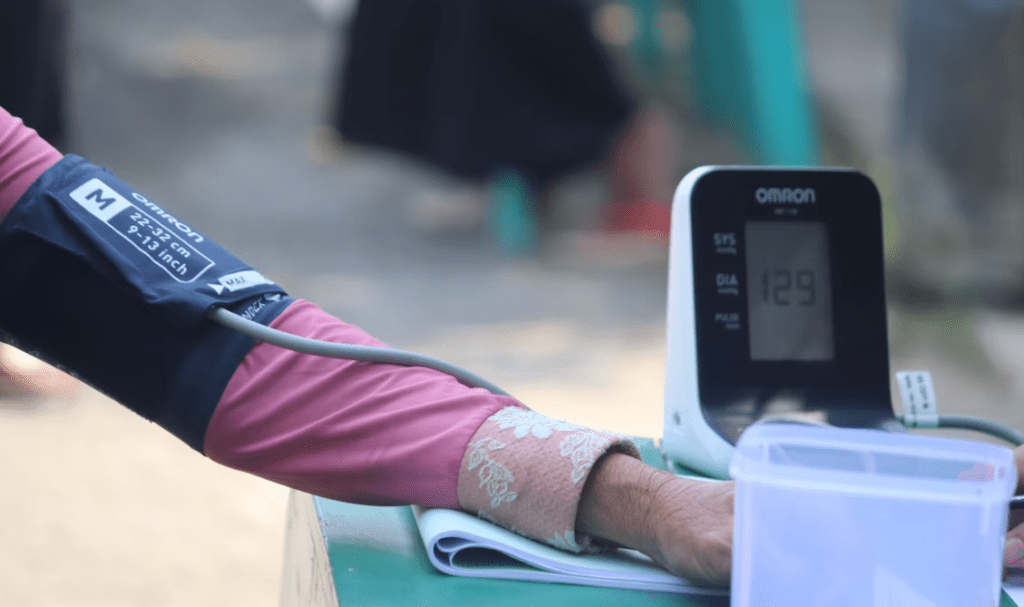Can Meditation Lower Blood Pressure?
Learn how meditation can lower blood pressure.

Selfpause Affirmation App
Download the app to get 1,000’s of affirmation meditations and everything you need to write, record and listen to your own.
Studies show that transcendental meditation can lower blood pressure. It can reduce both systolic and diastolic pressure. One study found that the use of transcendental meditation reduced systolic blood pressure by 3.5 points and diastolic blood pressure by 3.4 points.
Transcendental Meditation Reduces Blood Pressure

Several studies have shown that Transcendental Meditation (TM) reduces blood pressure in adults. In one meta-analysis of nine randomized controlled trials, the meditation technique was found to significantly lower both systolic and diastolic blood pressure. These changes were clinically meaningful.
The researchers who conducted the study are Dr. Frank Treiber, Dr. Gaston Kapuku, and Dr. Mills. In their study, the participants were randomly assigned to one of two groups: one group received Transcendental Meditation instruction, while the other received a health education class. Throughout the study, blood pressure levels were monitored through 24-hour devices. The meditation group showed a significant reduction in left ventricular mass compared to the control group.
The study also found that Transcendental Meditation reduced the effects of stress, anxiety, and depression. Unlike conventional treatments such as medications, Transcendental Meditation is inexpensive and not a drug. It can be incorporated into a treatment plan for hypertension or used on its own.
Transcendental Meditation uses a mantra to help the mind settle down and move beyond the present moment. The practice is said to reduce high blood pressure, reduce stress, and reduce the risk of heart disease. Practicing the technique is a simple and effortless mental process. Practitioners of TM can do the exercises alone or with a trained teacher.
While Transcendental Meditation does not work miracles, it may be a good way to reduce stress and blood pressure. It is possible to practice meditation for as long as you wish, but you may find the benefits more lasting as you practice. In addition to practicing meditation, breathing exercises may also be useful. These breathing exercises will help lower your blood pressure when you’re stressed or anxious.
Mindfulness Reduces Blood Pressure

The benefits of meditation for high blood pressure are many, and researchers believe it can be an effective treatment. This practice involves increasing body awareness and meditation, which helps regulate blood pressure. It has also been shown to improve heart health and reduce anxiety. As a bonus, meditation can also help those with high blood pressure to take their medications more consistently.
The researchers found that meditation lowers blood pressure by relaxing nerve signals. This helps the heart to function properly, reducing the risk of heart disease and heart attacks. Meditation also reduces the sensation of pain, which can be physical or mental. In addition, the practice of mindfulness meditation can improve a patient’s quality of life and reduce symptoms of depression.
The study involved 20 novice and experienced meditators. They were monitored during meditation sessions on the first and last days of a retreat. Participants wore a patch to record ECG data while they meditated. Half of the participants also wore a wireless EEG headset. The researchers analyzed the results using a mixed-effect autoregressive model.
In addition to improving sleep quality, meditation is also beneficial for reducing stress levels. It can help people better cope with stressful situations and reduce the risk of heart disease. While these are not the only benefits of meditation, these benefits should not be discounted. Meditation has been linked to improved blood pressure in patients with hypertension, but it is still not a cure-all for hypertension.
Breathing Exercises Lower Blood Pressure

Breathing exercises are an excellent way to reduce your blood pressure. They can help you lower your blood pressure fast and stay that way for weeks or months. It’s important to practice them regularly, especially before blood pressure measurements or stressful situations. The more you practice, the more you’ll notice the difference.
Breathing exercises are not a replacement for exercise and medication. They are a useful addition to lifestyle approaches that include both physical activity and healthy eating. Everyone needs regular exercise to stay healthy. Regular exercise helps improve certain health conditions, especially for older people. Breathing exercises are, however, an easy and convenient way to lower your blood pressure and improve your heart’s health.
One study found that people who practiced breathing exercises for at least 5 minutes daily for six weeks had lower blood pressure. The exercises resulted in a reduction in systolic blood pressure of 9 mmHg. Researchers said that these results were just as effective as those from lifestyle changes and blood pressure medication.
Breathing exercises are an excellent way to manage stress and improve your health. Studies show that they can lower blood pressure in both men and women. People with hypertension should try breathing exercises to manage their stress. Breathing techniques should be practiced daily and can be used when you feel stressed.
Transcendental Meditation

Transcendental meditation is a type of relaxation that involves sitting in a comfortable position and closing your eyes for twenty minutes twice a day. It has been shown to have beneficial effects on blood pressure and has been associated with a lower risk of mortality and cardiovascular disease. This study was published in the journal PLOS One. It is not the first to show that meditation can help lower blood pressure. Earlier research has demonstrated that meditation can reduce blood pressure in a number of different ways.
The study found that daily Transcendental meditation practice reduced blood pressure in teens with high-normal blood pressure. The teens who practiced the meditation regularly over the course of four months saw their pressure fall steadily. In addition, they tended to maintain the lower pressures after the study was over.
In 2007, Dr. James Anderson of the University of Kentucky and his team conducted a meta-analysis of previous studies to assess the effects of meditation on the cardiovascular system. They found that a program combining transcendental meditation with stress reduction techniques significantly reduced the risk of heart attacks and strokes. This is an extremely significant result, considering that cardiovascular disease is one of the leading causes of death and disability in the U.S. and worldwide.
The results of the study showed that a Transcendental Meditation program reduced blood pressure by an average of 2.8 points. This is a significant reduction compared to other stress reduction programs and relaxation techniques. Additionally, the program reduced overall mortality rates.
Immortal Emperor Changqing

According to some research, the Meditation by Immortal Emperor Changqing, a practice that uses the power of pure spirit, can lower blood pressure and lower the risk of cardiovascular disease. The technique involves practicing various forms of meditation and it can be performed at any age. However, it requires a certain level of expertise and practice. The main purpose of this technique is to lower blood pressure.
This type of meditation helps people lower their blood pressure by relaxing the body. The Immortal Emperor Changqing form of meditation is said to lower blood pressure by up to ten points. In addition to lowering blood pressure, it is said to reduce other health problems including hypertension, diabetes, and heart disease.
The benefits of meditation for high blood pressure are still being investigated. However, some preliminary studies have shown that meditation can lower blood pressure over a long period of time. According to one study, people who practiced transcendental meditation had lower blood pressure compared to people with normal blood pressure. Another study looked at cardiovascular disease and concluded that meditation practice reduced the risk of heart attack and stroke by 50%.
Mindfulness Reduces Inflammation

Meditation may lower blood pressure by reducing inflammation. This is important because inflammation is the major contributor to high blood pressure. However, there is little evidence that meditation can reduce pressure for an extended period of time. However, studies of meditation-like practices have shown that they can lower blood pressure for a short period of time.
The relaxation response is mediated by nitric oxide, a hormone that helps relax the blood vessels and keep blood pressure in control. In one study, people with high blood pressure showed a higher level of nitric oxide in their breaths compared to those who did not participate in the meditation. Researchers recommend practicing the relaxation response at least twice daily for 10 to 20 minutes. To achieve this, they recommend silent repetition.
Cardiovascular disease is a leading cause of mortality and morbidity worldwide. While traditional treatments focus on pharmaceuticals and physical interventions, meditation has been practiced for centuries and has been shown to induce beneficial changes in the cardiovascular risk profile. However, there has been debate about the validity of the research into meditation as a form of treatment.
Recent research has found that meditation can alter gene expression. Researchers at Harvard University discovered that people who meditated for 15 minutes daily showed a significant change in the expression of 172 genes associated with glucose metabolism and inflammation. Further, they found that participants who practiced meditation for at least 15 minutes a day saw meaningful decreases in blood pressure.
In summary, transcendental meditation uses a mantra to help the mind settle down and move beyond the present moment. The practice is said to reduce high blood pressure, reduce stress, and reduce the risk of heart disease, and while Transcendental Meditation does not work miracles, it may be a good way to reduce stress and blood pressure.
Our Top FAQ's
Meditation is a mental practice that involves focusing the mind on a specific object, thought, or activity to achieve a state of greater calm and relaxation. It is believed that meditation can alter brain function and improve physical and emotional well-being.
Yes, there is scientific evidence to support the claim that meditation can lower blood pressure. Several studies have shown that regular meditation practice can reduce systolic and diastolic blood pressure, as well as heart rate, in people with hypertension.
Meditation is generally considered to be a safe and effective way to lower blood pressure, and it has the added benefit of being a natural, drug-free method. However, it is important to consult with a healthcare provider before starting any new treatment for high blood pressure, including meditation. It is also important to note that meditation should not be used as a replacement for medication or other recommended treatments.
As with any practice, there are potential risks and drawbacks to using meditation as a way to lower blood pressure. Some people may find it difficult to establish a regular meditation practice, and it can take time to see the full effects on blood pressure. In addition, some people may experience temporary side effects from meditation, such as dizziness or headache. It is important to talk to a healthcare provider about any concerns or adverse effects from meditation.
To incorporate meditation into their daily routine, a person can start by setting aside a small amount of time each day to practice meditation. This can be as little as five or ten minutes at first, and the length of time can be gradually increased as the person becomes more comfortable with the practice. It is also helpful to find a quiet, comfortable space to meditate, and to choose a specific time of day to practice. Some people find it helpful to use an app or guide to help them learn and practice meditation techniques.
